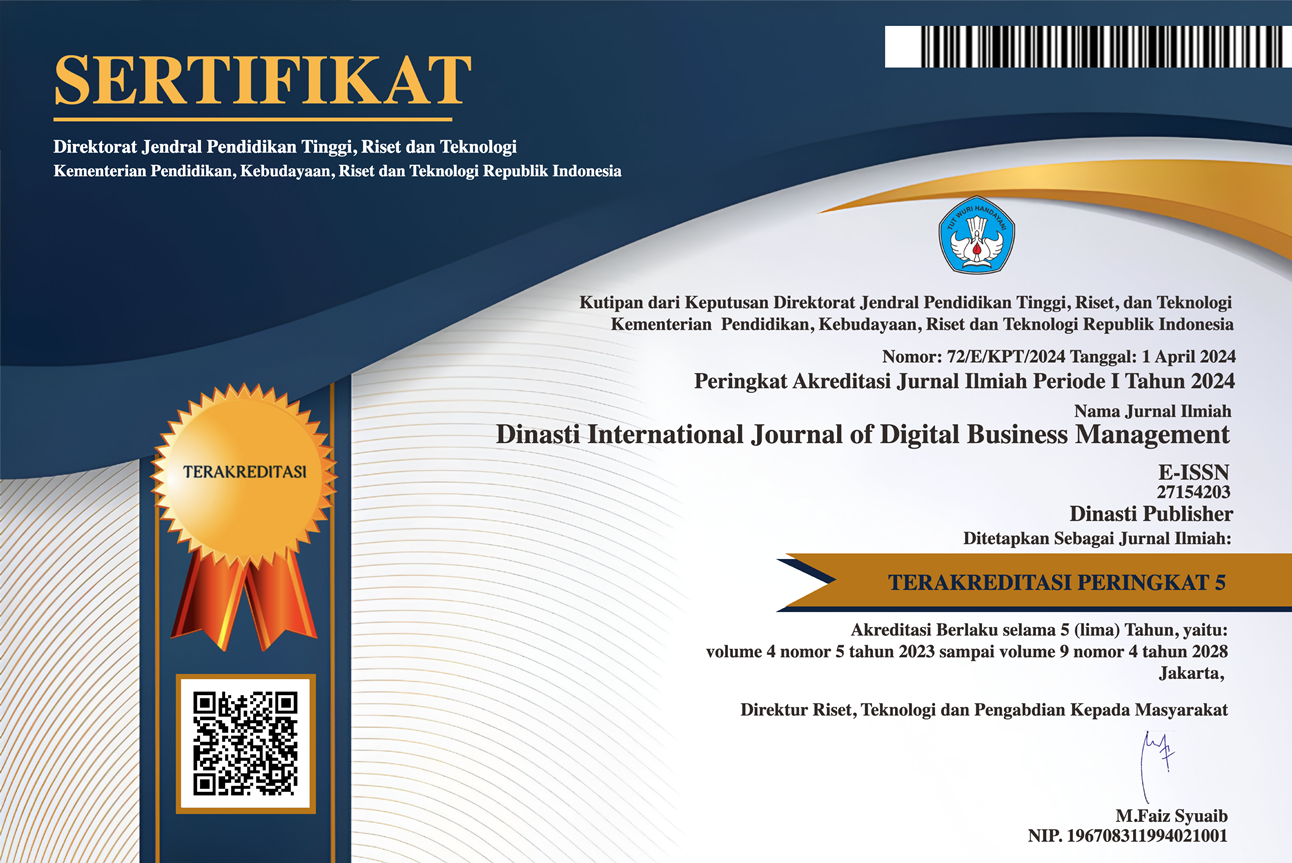Investigating the Influence of Perceived Behavioral Control and Personal Innovativeness on the Adoption of Online Fashion Shopping among Generation X: A TAM Approach”:
DOI:
https://doi.org/10.38035/dijdbm.v5i4.2949Keywords:
Perceived Behavioral Control, Personal Innovativeness, Online Fashion Shopping, TAM, Generation XAbstract
Online shopping has experienced rapid growth in the digital age, and understanding the factors influencing the adoption of online shopping by Generation X is becoming important for businesses such as e-commerce, marketers, and researchers. The purpose of the study was to understand the interaction between Perceived Behavioral Control and Personal Innovativeness in influencing the intention of online fashion shopping adoption in Generation X. This research is quantitative and qualitative, using the TAM approach. A sample of 50 Generation X men and women born between 1965 and the 1980s were users of online fashion shopping applications. Varibel X, there are 2 namely Perceived Behavioral Control and Personal Innovativeness. Variable Y, is the Intention to Use Online Fashion Shopping Apps. Data analysis uses simple correlation tests, and descriptive statistics such as mean, median, and standard deviation. Analyzed using SPSS statistical software. Data analysis includes validity and reliability tests. Instrument, descriptive analysis, and linear regression test to test the effect of the independent variable on the dependent variable. Personal Innovativeness positively influences the Intention to Use Online Fashion Shopping. It was found that Perceived Ease of Use had a significant influence on Intention to Use Online Fashion Shopping. Perceived Usefulness also positively affects the Intention to Use Online Fashion Shopping. Research shows that the factors of the TAM approach, namely Perceived Ease of Use, Perceived Usefulness, Perceived Behavioral Control, and Personal Innovativeness, have an important role in influencing Generation X's intention to adopt Online Fashion Shopping. The research can also provide valuable insights for e-commerce companies and fashion industry players in developing and improving online shopping applications that are more attractive and easy to use for Generation X.
References
Abdelsalam, S., Salim, N., Alias, R. A., & Husain, O. (2020). Understanding Online Impulse Buying Behavior in Social Commerce: A Systematic Literature Review. IEEE Access, 8, 89041–89058. https://doi.org/10.1109/ACCESS.2020.2993671
Abuhassna, H., Yahaya, N., Zakaria, M. A. Z. M., Zaid, N. M., Samah, N. A., Awae, F., Nee, C. K., & Alsharif, A. H. (2023). Trends on Using the Technology Acceptance Model (TAM) for Online Learning: A Bibliometric and Content Analysis. International Journal of Information and Education Technology, 13(1), 131–142. https://doi.org/10.18178/ijiet.2023.13.1.1788
Alldieck, T., Magnor, M., Xu, W., Theobalt, C., & Pons-Moll, G. (2018). Video Based Reconstruction of 3D People Models. Proceedings of the IEEE Computer Society Conference on Computer Vision and Pattern Recognition, 8387–8397. https://doi.org/10.1109/CVPR.2018.00875
Alsyouf, A., Lutfi, A., Alsubahi, N., Alhazmi, F. N., Al-Mugheed, K., Anshasi, R. J., Alharbi, N. I., & Albugami, M. (2023). The Use of a Technology Acceptance Model (TAM) to Predict Patients’ Usage of a Personal Health Record System: The Role of Security, Privacy, and Usability. International Journal of Environmental Research and Public Health, 20(2). https://doi.org/10.3390/ijerph20021347
Chen, M., & Allebach, J. (2014). Aesthetic quality inference for online fashion shopping. Imaging and Multimedia Analytics in a Web and Mobile World 2014, 9027, 902703. https://doi.org/10.1117/12.2045269
Dabija, D. C., Bejan, B. M., & Tipi, N. (2018). Generation X versus millennials communication behaviour on social media when purchasing food versus tourist services. E a M: Ekonomie a Management, 21(1), 191–205. https://doi.org/10.15240/tul/001/2018-1-013
Fook, L. A., & McNeill, L. (2020). Click to buy: The impact of retail credit on over-consumption in the online environment. Sustainability (Switzerland), 12(18). https://doi.org/10.3390/SU12187322
Juaneda-Ayensa, E., Mosquera, A., & Murillo, Y. S. (2016). Omnichannel customer behavior: Key drivers of technology acceptance and use and their effects on purchase intention. Frontiers in Psychology, 7(JUL), 1–11. https://doi.org/10.3389/fpsyg.2016.01117
Jung, T., Chung, N., & Leue, M. C. (2015). The determinants of recommendations to use augmented reality technologies: The case of a Korean theme park. Tourism Management, 49, 75–86. https://doi.org/10.1016/j.tourman.2015.02.013
Kawaf, F. (2019). Capturing digital experience: The method of screencast videography. International Journal of Research in Marketing, 36(2), 169–184. https://doi.org/10.1016/j.ijresmar.2018.11.002
Kawaf, F., & Istanbulluoglu, D. (2019). Online fashion shopping paradox: The role of customer reviews and facebook marketing. Journal of Retailing and Consumer Services, 48(January), 144–153. https://doi.org/10.1016/j.jretconser.2019.02.017
Ladhari, R., Gonthier, J., & Lajante, M. (2019). Generation Y and online fashion shopping: Orientations and profiles. Journal of Retailing and Consumer Services, 48(January), 113–121. https://doi.org/10.1016/j.jretconser.2019.02.003
Lee, J., & Lee, Y. (2019). Does online shopping make consumers feel better? Exploring online retail therapy effects on consumers’ attitudes towards online shopping malls. Asia Pacific Journal of Marketing and Logistics, 31(2), 464–479. https://doi.org/10.1108/APJML-06-2018-0210
Mailizar, M., Almanthari, A., & Maulina, S. (2021). Examining teachers’ behavioral intention to use e-learning in teaching of mathematics: An extended tam model. Contemporary Educational Technology, 13(2), 1–16. https://doi.org/10.30935/CEDTECH/9709
Martos, V., Ahmad, A., Cartujo, P., & Ordoñez, J. (2021). Ensuring agricultural sustainability through remote sensing in the era of agriculture 5.0. Applied Sciences (Switzerland), 11(13). https://doi.org/10.3390/app11135911
Morotti, E., Donatiello, L., & Marfia, G. (2020). Fostering fashion retail experiences through virtual reality and voice assistants. Proceedings - 2020 IEEE Conference on Virtual Reality and 3D User Interfaces, VRW 2020, 338–342. https://doi.org/10.1109/VRW50115.2020.00074
Natarajan, T., Balasubramanian, S. A., & Kasilingam, D. L. (2018). The moderating role of device type and age of users on the intention to use mobile shopping applications. Technology in Society, 53, 79–90. https://doi.org/10.1016/j.techsoc.2018.01.003
Patil, P., Tamilmani, K., Rana, N. P., & Raghavan, V. (2020). Understanding consumer adoption of mobile payment in India: Extending Meta-UTAUT model with personal innovativeness, anxiety, trust, and grievance redressal. International Journal of Information Management, 54(February), 102144. https://doi.org/10.1016/j.ijinfomgt.2020.102144
Przymusza?a, P., Szmelter, J., Zieli?ska-Tomczak, ?., Cerbin-Koczorowska, M., & Marciniak, R. (2023). Future physicians’ behavioral intentions towards collaborative practice - a qualitative study on polish final-year medical students guided by the theory of planned behavior. BMC Medical Education, 23(1), 1–14. https://doi.org/10.1186/s12909-023-04136-0
Rafki, R., Nofriadi, N., Oktarina, Y., Nurhaida, N., Lestari, R., & Mustika, N. (2023). Factors Influencing Behavioral Propensity To Use Mobile Shopping Apps In Generation X: The Tam Approach. ARRUS Journal of Social Sciences and Humanities, 3(1), 1–8. https://doi.org/10.35877/soshum1715
Rafnelly Rafki a, Rinda Lestarib, Nofriadi Nofriadi c, Yolanda Oktarinad, N. M. (2023). FAKTOR YANG MEMPENGARUHI NIAT MENGGUNAKAN APLIKASI BELANJA SELULER DI KALANGAN GENERASI X?: PENDEKATAN DENGAN APLIKASI UTAUT. JURNAL AKUNTANSI, EKONOMI DAN MANAJEMEN BISNIS, 3(1), 122–129.
Samartha, V., Shenoy Basthikar, S., Hawaldar, I. T., Spulbar, C., Birau, R., & Filip, R. D. (2022). A Study on the Acceptance of Mobile-Banking Applications in India—Unified Theory of Acceptance and Sustainable Use of Technology Model (UTAUT). Sustainability (Switzerland), 14(21). https://doi.org/10.3390/su142114506
Shittu, I., & Salisu, Y. (2023). Attitude, Subjective Norm, Perceived Behavioural Control and Digital ?uk?k Adoption in Nigeria: the Mediating Effect of Awareness. ISRA International Journal of Islamic Finance, 15(2), 4–19. https://doi.org/10.55188/ijif.v15i2.539
Singh, P., & Keswani, S. (2016). “ A Study of Adoption , Behavior for Online Shopping?: An Extension of TAM Model ” Username Download this PDF file Password Author Desk Past Issues Articles in Press Indexing?» Paper Tamplate (/ Author _ desk / Paper _?» Copy Right (/ Author _ desk / Copy. February.
Venkatesh, V., & Davis, F. D. (2000). 1.A theoretical extension of the technology acceptance model. Management Science, 46(2), 186–204. https://doi.org/10.1287/mnsc.46.2.186.11926
Downloads
Published
Issue
Section
License
Copyright (c) 2024 Rafnelly Rafki, Annisa Suci Ramadhani, Hapzi Ali, Sri Langgeng Ratnasari

This work is licensed under a Creative Commons Attribution 4.0 International License.
Authors who publish their manuscripts in this journal agree to the following conditions:
- The copyright on each article belongs to the author(s).
- The author acknowledges that the Dinasti International Journal of Digital Business Management (DIJDBM) has the right to be the first to publish with a Creative Commons Attribution 4.0 International license (Attribution 4.0 International (CC BY 4.0).
- Authors can submit articles separately, arrange for the non-exclusive distribution of manuscripts that have been published in this journal into other versions (e.g., sent to the author's institutional repository, publication into books, etc.), by acknowledging that the manuscript has been published for the first time in the Dinasti International Journal of Digital Business Management (DIJDBM).















































